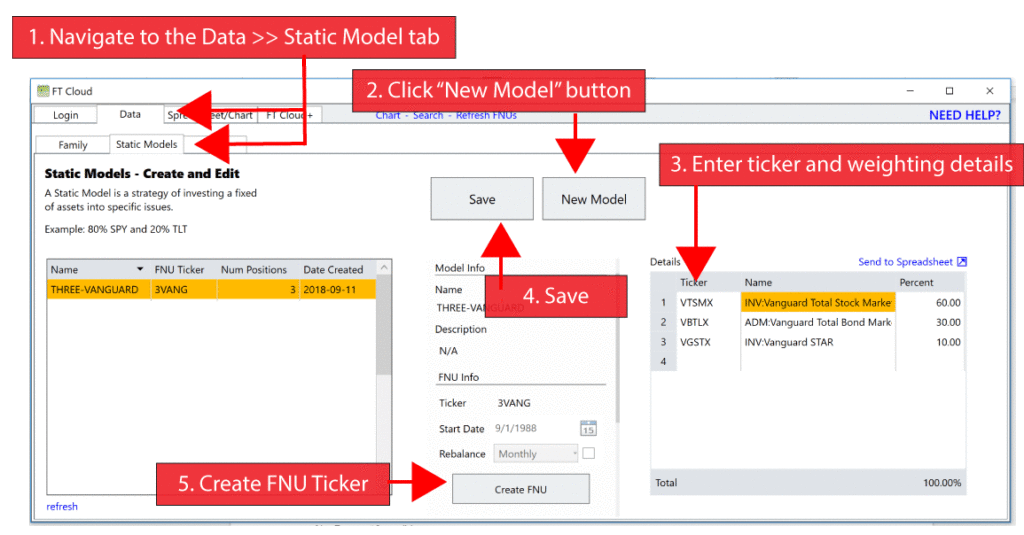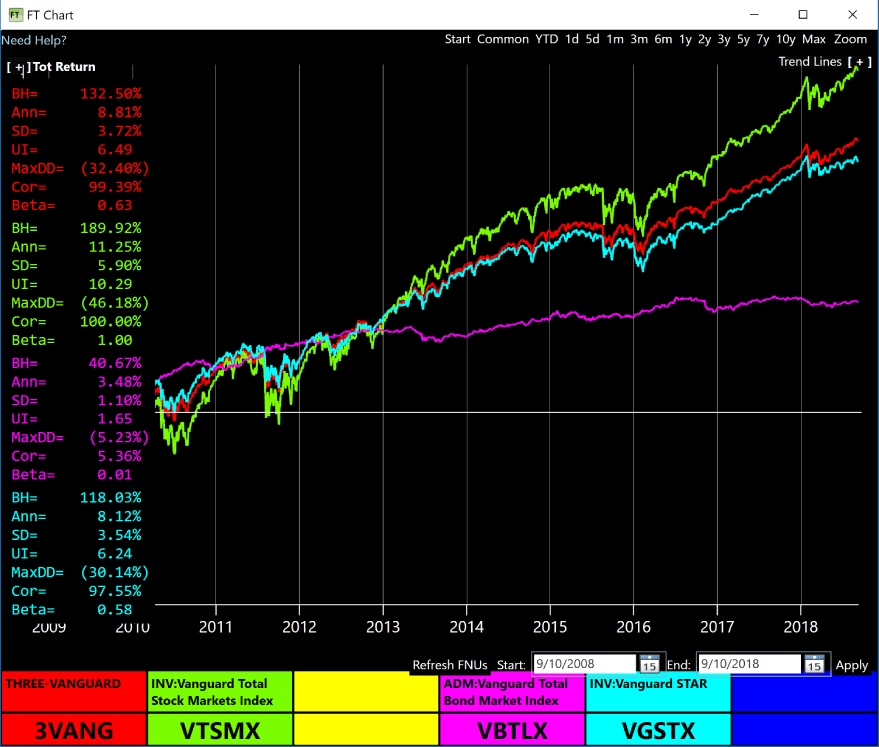Dual Momentum Investing

Summary
In this post, we’ll reproduce Gary Antonacci’s dual momentum strategy using FT Cloud, Investors FastTrack’s data and portfolio modeling product.
Dual momentum is covered in detail in Antonacci’s 2014 book Dual Momentum Investing (http://a.co/bgR4Jx8). It’s a 10 chapter easy ready.
Sign up for a free trial of FT Cloud here and follow along. No credit card is required.
Momentum Basics
There are two types of momentum investing- Relative Momentum and Absolute Momentum.
Relative Momentum
Relative Momentum is very popular with FastTrackers. Relative momentum is a binary comparison, between assets A and B. Traditionally you invest in asset A when its trend is strongest and asset B when its trend is strongest.

Above is a classic example is small caps vs large caps. In the chart above, we see the results of owning Small Caps (IWM – iShares Russell 2000 ETF) when its trend is stronger than Large Caps (SPY – SPDR S&P 500 ETF), and vice versa.
Using In FT4web and FT Cloud, this is done with the R and J charts (https://investorsfasttrack.com/help/spreadsheet/ftchart/available-charts/). Or, a more advanced twist is the off the shelf FT Cloud momentum model (https://investorsfasttrack.com/basic-skills-videos/)
Absolute Momentum
Absolute Momentum compares the performance of an asset to a fixed target, not a relative target. In his book, Antonacci compares excess returns of an asset over cash during a 12 month period to calculate a positive or negative momentum.
Antonacci combines both Relative Momentum and Absolute Momentum (ie “dual” momentum). In FT Cloud+, the dual momentum concept is called the “hurdle rate.” Full documentation is here: https://investorsfasttrack.com/help/other/hurdle-rate/
Summary – Modeling Dual Momentum

In the chart above (3/18/05 – 3/18/19), the GREEN LINE is the results of the dual momentum model in FT Cloud (model detailed below). This line is the result of trading between:
- IOTO – iShares Core S&P Total US Stk Mrkts ETF
- EFA – iShares MSCI EAFE ETF
- TLT – iShares 20+ Year Treasury Bond ETF
As the chart above depicts, employing a dual momentum strategy keeps the portfolio out of the 2008-2009 drawdown (by shifting to TLT when IOTO and EFA both perform lower than the hurdle rate TLT). Then again shifts to IOTO or EFA when regular conditions markets resume.
Backtest Dual Momentum in FT Cloud+
This is a complex model, but simple to execute in FT Cloud. Basically, we need to create an investment universe of the two iShares ETFs, IOTO and EFA. In FT Cloud this is called a “family.” (
https://investorsfasttrack.com/what-is-a-family/ )
Then, explained in plain English, the models works in two steps:
- Step 1, every quarter rank the family over the trailing 12 months, then pick the fund with the highest total return.
- Step 2, compare that fund to the total return of TLT (the hurdle) over the same period and invest 100% of proceeds in the ETF with the highest total return
The setup is about 4 button clicks in FT Cloud and outlined below in the step by step. Additionally, you can expand on this model buy adding more funds to the family and creating more complex hurdle rates (
https://investorsfasttrack.com/help/other/hurdle-rate/ ).
Also, in FT Cloud we produce logs for all the calculations, so you can audit all calculations.
Dual Momentum – Step by Step
1. Sign up for Trial
2. Build Dual Momentum Family
- Navigate to the Data >> Family tab.
- Click “New Family.”
- Enter the “Dual Momentum” in the “Name” field.
- Enter IOTO and EFA in the details grid.
- Click “Save”
3. Build Dual Momentum Model

- Navigate to FT Cloud+ >> Compare
- Under the RED model, input:
- # to buy = 1
- % to sell = 100%
- Family = “Dual Momentum”
- Rank By = Return
- Tr Delay = 1
- Rnk Period = Quarter
- Rebalance = Annual
- Model = Momentum
- . For this dual momentum option, % to sell MUST be 100% and the # to buy MUST be 1. All other parameters can be customized.
4. Add Hurdle Rate (FT Cloud’s Dual Momentum)

- Still on FT Cloud+ >> Compare, click “hurdle rate” on the right middle of the screen to display the Hurdle Values parameter input
- Check the checkbox next to the red rectangle to activate the red model’s hurdle rate.
- Add “TLT” in the “Hurdle” input
- Check the checkbox next to “replace”
- Click “apply.”
5. Run Model
Press run at the upper right of the FT Cloud+ >> Compare screen.
- The bottom half of the FT Cloud+ >> Compare screen will display a chart.
- The grey line is the benchmark (set with the benchmark input on the upper right).
- The red line is the dual momentum model.
- Statistics for the time period are displayed in the right of center area titled “Statistics”











